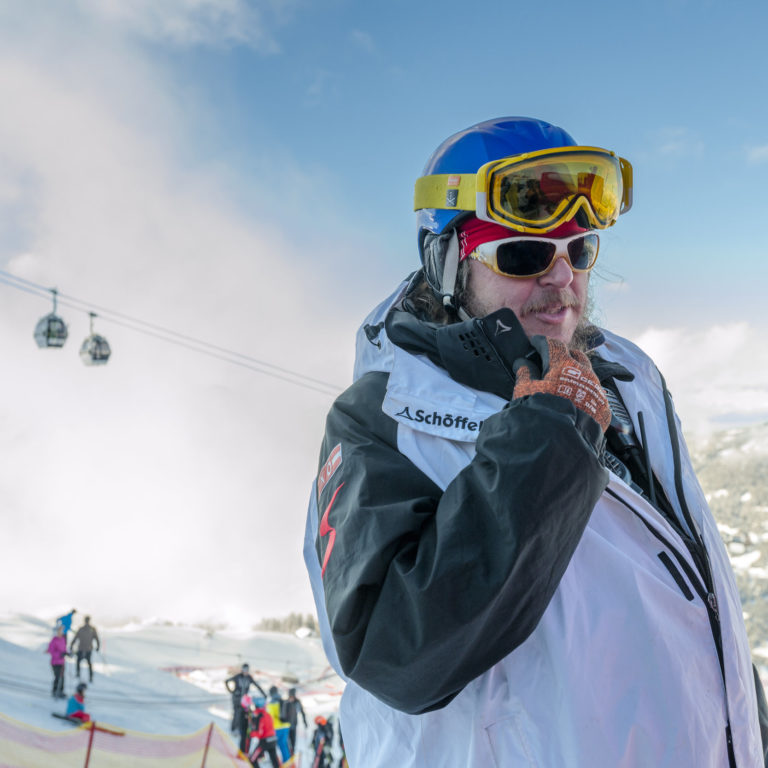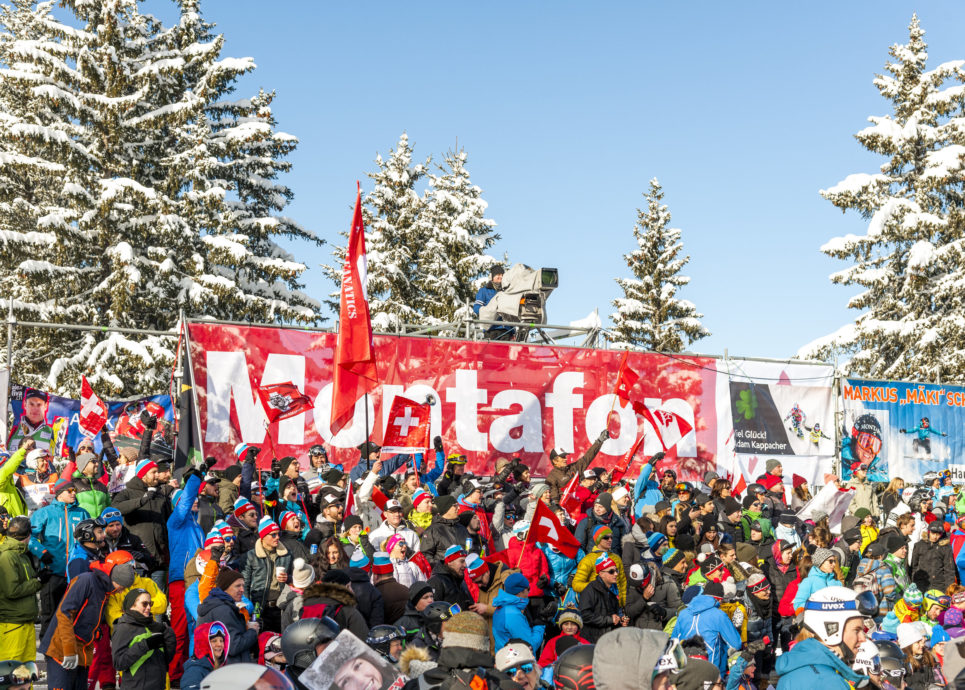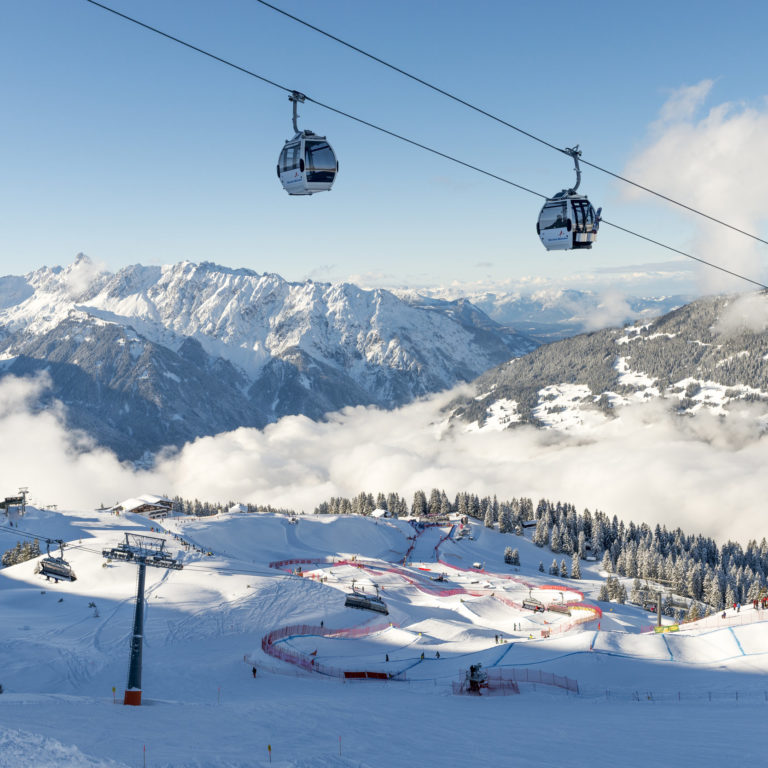


Christoph Arndt keeps an eye on everything from his position next to the starting box

C Weltcup Montafon Bergbahn Silvretta Montafon © Gregor Lengler / Vorarlberg Tourismus
The world’s top-ranking ski-cross and snowboard-cross athletes meet in the Silvretta Montafon ski resort to test themselves against each other every year in December.It’s a huge sports event that takes place in Schruns and on the slopes – one that would not be possible without the help of the many volunteers. We took a look behind the scenes.
TEXT: FABIAN TEUBER
Skiers… ready? – Attention!” The flaps on the starting block drop with a bang, the first four opponents throw themselves into the halfpipe, which is a good three metres deep, whiz out at the other end again and head towards the first sharp bend. There’s a difference in altitude of around 200 metres from the start, which lies a little below the Hochjoch summit, to the finish, which is located near the cable car’s mountain station.
The winter sports professionals race down the 985-metre-long World Cup track at speeds of up to 65 kilometres per hour – the rapid descent takes barely 60 seconds. The atmosphere at the finishing line is like that at football stadiums: the excited spectators watch the race on a large screen and flags are waved in the filled-to-capacity grandstand. The noise from the vuvuzelas almost drowns out the party hits blasting from the loudspeakers.
The ski-cross and snowboard-cross track is similar to the ones seen at BMX events – only it’s made of snow. A total of 80,000 cubic metres of snow is needed to create the venue’s 32 elements: a halfpipe, five sharp bends, various jumps and bumps. The rough preparatory work for the Double World Cup on the mountain is handled by a specially designed digger – but most of it still needs to be done by hand: the ‘shapers’ use all kinds of standard gardening tools to get the snow into shape. A good five kilometres of safety nets and barrier nets are installed around the track in addition to the kilometres of cables needed for timekeeping and, of course, for the television cameras.
The events in both disciplines are held over three days. The preparations take months and the serious work commences a good two weeks before the weekend of the event. The World Cup is organised in perfect cooperation by Montafon Tourism, Silvretta Montafon and the ski clubs in the valley. The volunteer fire brigade and the Red Cross also get involved as do 13 clubs and three schools. Many helpers take leave from their work and some even travel from far afield to help at the event. Everybody feels privileged that they can join in. Why, you’d ask yourself, do they do it? The answer is: some of the best winter sports personalities in the world are from the Montafon. Some of them have even competed in the Olympics and have represented the valley across the world. And they’re also often club mates. That’s why they want the competitors to enjoy the best possible conditions at their home derby.
Many helpers take leave from their work and some even travel from far afield to help at the event.
The first 40 helpers drive up the mountain in the dark at the beginning of each race day to bring the course back up to competition standards. The cable car doesn’t actually run that early, it’s only been put into operation for the hard core. Most of those standing crowded together in the car look tired because they already climbed out of bed at four in the morning the day before – and only got back down to the valley at seven in the evening. The mood remains buoyant in spite of the occasional suppressed yawn.
Upstairs, in the cosy and warm green room, the first thing to do is get a bread roll. A total of 250 are consumed every day – in addition to all the fruit, cereal bars and mini-salamis. The coffee machine hums almost continuously. A queue quickly forms in front of Dorle Hübler: She’s responsible for handing out the variously coloured bibs. “Slipper, track or gate judge?”, she asks. The ‘slippers’ ski in single file down the track before and between the heats sliding at offsets through the sharp bends to scrape the loose snow off the course and level it out. The gate judges and track marshals spread out across the track, somewhere between start and finish, to keep an eye out for any violations; but they’re also quickly to hand if any of the competitors suffer a fall.
The cross competitors also compete at the Olympics
Ski cross has been an Olympic discipline since 2010, snowboard cross since 2006, so they are quite young sports but they’re growing rapidly in popularity. Four competitors face off on a course with halfpipes, ski jumps and sharp bends during several heats of the knock-out competition in which the two fastest athletes advance to the next round. More than 200 competitors from 27 nations have registered to take part in both disciplines at the World Cup in the Montafon.
They keep in touch with the race directors by radio. And then there are the ‘dyers’. They spray blue markings along the edge of the track and on the obstacles on the snow. That’s when they don their white painter’s suits, which are already speckled blue from the previous days’ work. Snowmobiles are waiting outside to tow the skiers up to the starting line. In the beam of the headlamps, the course is now ‘slipped’, sharp bend after sharp bend. The track is ready for the first training runs at half past seven and the competitors have started to get ready on the terraced slope behind the so-called starting box. That’s where the boards are waxed and the final preparations are made. Race Director Christoph Arndt has already taken up position in the starting area.
We’re all winter sports enthusiasts here.
He can see along the entire route from here. He’s one of the first on the mountain in the morning and pretty much the last to return. Three radios dangle from his neck, plus a ‘man in the ear’ – and should there be radio silence for once, his mobile phone is bound to start ringing immediately. The job is stressful but it doesn‘t seem to be bothering the 47-year old… on the contrary, he actually seems to be really enjoying himself. At times, he has to raise his voice but somehow he manages to maintain his good spirits. Like him, all the people here are ‘winter sports enthusiasts’ and ‘glass-half-full types’ who are not discouraged by adverse weather conditions, he says.
The weather is one of those things: sure, there would be no winter sports without snow but there mustn’t be too much of the stuff either. The night before last, for example, the wind had knocked down the fences across large sections of the track and fresh snow had fallen on it, so the helpers were out and about on the mountain from four in the morning. But their combined efforts resulted in everything being returned to perfect order again on schedule. But then it snowed like mad and a fog came up – the qualification heats planned for the day had to be postponed in spite all the workers’ efforts.
At 1,500 metres lower down, a veritable festival area with open-air stage, marquee and snack stands is being created on the parking lot at the Hochjoch-Bahn valley station in Schruns. Mando Diao, the rock group from Sweden, is performing on the Saturday evening and DJs in the marquee are getting the crowd in the party mood. But the fact that 8,000 people will be turning up here for the closing party and that the main street will have been transformed into a colourful party venue is really not apparent on the Friday morning. But people don’t appear to be stressed, which is probably due to the laid-back character of the Montafon residents. The tent is already up and the stage is gradually taking shape.
The World Cup also marks the start of the winter season for the hospitality sector. Ewald Tschanhenz, for example, is a hotelier in nearby St. Gallenkirch; he’s opened a few days earlier than planned in order to put up four national snowboard teams at short notice. The enthusiastic hotelier was also the village’s mayor for several years. He thinks that the World Cup’s success and the fact that the entire region has become associated with it is mainly due to just one thing: the close solidarity that exists between the Montafon residents. It’s not unusual, for instance, for entire families to get involved as helpers; one good example is Eva-Maria Speckle’s family. The 27-year-old marks down the results of the heats and the next pairings on a board while her older brother is the race commentator at the finish; her parents also lend a hand. From the beginning, and again every year.
After 24 heats, the final results are in and the names of the competitors who will have the honour of climbing the winner’s podium are known. Until just a few minutes ago, that podium was hidden somewhere in the background between boxes and is now hurriedly being hoisted over the boards along with the inflatable display wall bearing the sponsors’ logos. The helpers start draping the champagne bottles on the steps. The winners will treat themselves to a hearty slug and commence their celebrations while the Montafon residents can also be proud of themselves – this year’s World Cup has been another great success.